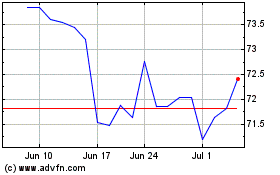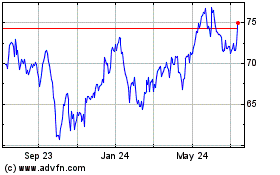By Cassandra Sweet
California utilities including PG&E Corp., Edison
International and Sempra Energy are testing new ways to network
solar panels, battery storage, two-way communication devices and
software to create "virtual power plants" that manage green power
and feed it into the power grid as needed.
The Golden State is ramping up renewable energy as it pledges to
be a bulwark against the Trump administration's pro-fossil fuel
policies. But first, it has to figure out what to do with all the
excess power it generates when the sun is shining and the wind is
blowing.
California's solar farms create so much power during daylight
hours that they often drive real-time wholesale prices in the state
to zero. Meanwhile, the need for electricity can spike after
sunset, sometimes sending real-time prices as high as $1,000 a
megawatt-hour.
Utility companies are looking to correct that supply-demand
mismatch and ease the strain on the electric grid as California
considers retiring its last nuclear plant in 2025 while nearly
doubling the power it gets from renewable sources to 50% by
2030.
Last month, power company AES Corp. flipped the switch on a bank
of 400,000 lithium-ion batteries it installed in Escondido, Calif.,
for Sempra Energy. Sempra's San Diego utility plans to use the
batteries, made by Samsung SDI Co. Ltd., to smooth out power flows
on its grid.
Tesla Inc. is supplying batteries to a Los Angeles-area network
that would serve Edison International, which would be the world's
largest of its kind when finished in 2020, according to the
developer, Advanced Microgrid Solutions. The network would spread
across more than 100 office buildings and industrial
properties.
When the Edison utility needs more electricity on its system,
the batteries would be able to deliver 360 megawatt-hours of extra
power to the buildings and the grid, enough to power 20,000 homes
for a day, on short notice. At other times, the batteries would
help firms hosting the arrays to cut their utility bills, said
Susan Kennedy, chief executive of Advanced Microgrid Solutions,
which is developing the project.
"It will show how you can use communication and control
technology to make a bunch of distributed energy assets act like
one big one," said J.B. Straubel, Tesla's chief technical
officer.
The companies declined to say how much the project would
cost.
PG&E plans to use clean energy to replace the 2,200-megawatt
Diablo Canyon nuclear power plant, which it is proposing to shut
down in 2025. The San Francisco utility, which plans to invest
about $1 billion through 2020 to modernize its grid, is testing
batteries, software and other technologies.
"We are rethinking the grid and how it operates," said Steve
Malnight, PG&E's senior vice president of strategy and
policy.
Virtual power plants remain a considerably more expensive option
than building a traditional power plant to meet peak demand.
Stored power from lithium-ion batteries can do the work of a
natural-gas peaker plant at an average cost of between $285 and
$581 a megawatt-hour, according to a December report by Lazard Ltd.
In contrast, electricity from a new gas peaker plant costs between
$155 and $227 a megawatt-hour, according to Lazard.
But some of the equipment barely existed five years ago: As
prices for technologies such as battery storage fall, utilities
should be able to adopt more of them, said Michael Picker,
president of the state Public Utilities Commission.
California currently has to sell excess solar power at low
prices or give it away to utilities in Arizona and other states,
through a real-time power market run by California's Independent
System Operator, which oversees the state grid.
Sometimes, offering the excess power at low prices isn't enough
and prices go negative, as a way for power suppliers to encourage
other utilities to take power they can't use. That happened on 178
days last year.
Utilities in Colorado, New York and other states that plan to
get a higher percentage of their power from renewables are also
experimenting with virtual power-plant technology.
Consolidated Edison Inc. is using solar panels, batteries and
power conservation technologies at several dozen New York City
buildings to reduce peak demand by as much as 52 megawatts. Because
of the $200 million project, the utility can postpone installing
more than $1 billion of conventional power equipment for another 20
years, said Matthew Ketschke, a Con Edison vice president.
Virtual power plants alone, however, may not solve problems
created by boosting intermittent renewable energy.
In Arizona, regulators want to double the state's renewable
energy target to 30% by 2030. But some utilities worry that adding
more solar power on top of California's already-robust supply could
be costly and wasteful, even with battery storage.
"Storage may help you within the day, but a battery isn't
designed to store energy from March until it's needed in June,"
said Jeff Guldner, senior vice president of public policy at
Arizona Public Service Co. in Phoenix.
Write to Cassandra Sweet at cassandra.sweet@wsj.com
(END) Dow Jones Newswires
March 04, 2017 07:14 ET (12:14 GMT)
Copyright (c) 2017 Dow Jones & Company, Inc.
Edison (NYSE:EIX)
Historical Stock Chart
From Mar 2024 to Apr 2024

Edison (NYSE:EIX)
Historical Stock Chart
From Apr 2023 to Apr 2024
